 |
| |
|
|
||||||||||
|
|
 |
|||||
Angkor Wat There are few places on earth to match the splendour of Angkor Wat. The temple is the largest religious buildings ever constructed and is truly one of the wonders of the world Believed to have been undertaken as a temple and mausoleum for King Suryavarman II at the peak of the Khmer empire in the first half of the 12th century, Angkor Wat is the best-preserved of the Angkorian temples. As with other Angkorian temples and walled cities such as Angkor Thom, the central theme of Khmer architecture revolved around the idea of the temple-mountain. By the time building on Angkor Wat was begun early in the 12th century, this had been elaborated to a central tower surrounded by four smaller towers. The central monument represents the mythical Mount Meru, the holy mountain at the centre of the universe, which was home to the Hindu god Vishnu. The five towers symbolise Mount Meru's five peaks. It is difficult to express in words the enormous size of Angkor Wat, but it can be hinted at in part by a look at the scale of the complex. The temple is surrounded by a moat which makes the one around the Tower of London, built at roughly the same time, look like nothing more than a garden pond. At 190m wide and forming a rectangle 1.5km by 1.3km, it is hard to imagin z s around the walls of the outer gallery and the hundred figures of devadas and apsaras. This intricately carved gallery tells stories of the Hindu gods and of Suryavarman II's successes on the battlefield. A visit to Angkor Wat is the experience of a lifetime and will be cherished forever. |
 |
|||||
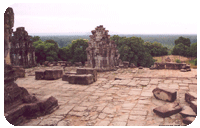 |
Phnom Bakheng Dominating the flat landscape, this 10th Century mountain temple is the most popular spot in the area to watch a classic sunset over Angkor Wat and the surrounding forest. |
|||||
Angkor Thom This huge walled complex was the centre of the world's largest city in 1200. The royal city was first built under the reign of Udayadityavarman II in the 11th Century. It was destroyed when the Chams from Vietnam invaded, sacking the city, and was subsequently rebuilt by King Jayavarman VII at the end of the 12th Century.Its vast walls, some 6m wide, 8m high and 13km in length contain many monuments. |
 |
|||||
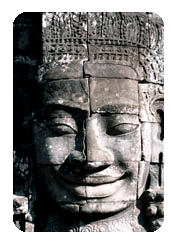 |
|
|||||
| The Baphuon This perfect pyramidal temple, built by Udayadityarvarman II, was the most poorly constructed of all the temples in Angkor. From the remaining ruins, it is possible to see how imposing it was. This temple mount was dedicated to Shiva, but in its reliefs many motives from Vishnu's life can be seen. Complexed work continues at the Baphuon to preserve it as a partial ruin complete with a huge reclining Buddha, added in the 16th Century. |
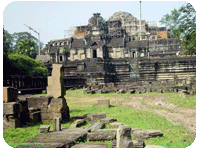 |
|||||
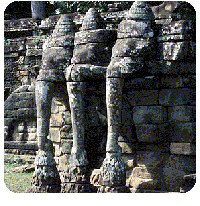 |
Terrace of Elephant Terrace of the Elephants and Terrace of the Leper KingAt the North of the Baphuon lies the original royal city, of which very little remains. The first terrace owes its name to the outstanding depiction of elephants, and was used as a viewing gallery at royal events, while the second terrace takes its name from the magnificent sculpture of King Yasovarman, popularly known as the Leper King. The original of this statue is now in the National Museum. |
|||||
| Ta Prohm This temple is perhaps the most atmospheric of all Angkor's treasures. The temple was a monastery built by Jayavarman VII as a residence for his mother. Ta Prohm has been left to the destructive power of nature by archaeologists to demonstrate the awesome power of nature. It has been largely consumed by the jungle and as you climb through the dilapidated stone structures you see many giant trees growing out of the top of the temple itself. At every turn you expect to see Indiana Jones or Lara Croft step out from behind a fallen pillar. It is one of the most regularly visited temples, with visitors often arriving during the middle of the day to take advantage of the protective forest canopy above the ruined temple. Ta Prohm looks as many of the monuments did when European explorers first laid eyes on them. |
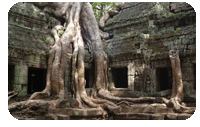 |
|||||
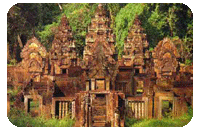 |
Banteay Srei This jewel of Angkor was built by a Brahman in the 10th Century and dedicated to Shiva. The famous pink sandstone structure bears a series of exquisite sculptures, lintels and friezes. These, it is said, must have been carved by women as the detail is too fine for the hands of a man. This gives the origin of the Khmer name, Fortress of the Women. While it may be a small temple complex, the beauty of Banteay Srei is found not in the scale, but the detail. Many believe the intricate carving is the best example of Khmer classical art in existence. |
|||||
| Kbal Spean Better known as the River of a Thousand Lingas, this is an area of riverbed carvings and lush jungle. There are several carvings of Hindu deities in the sandstone here, as well as thousands of lingas in the riverbed itself. This site was only ‘rediscovered' in 1969 and is a tranquil place with an attractive waterfall. It is 50km north of Siem Reap |
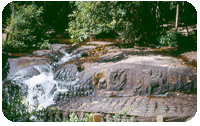 |
|||||
 |
Banteay Chhmar This temple is being developed to receive visitors and is a big complex meaning Narrow Fortress. It was badly looted in 1998, but efforts are now underway to preserve what remains. It is 160km northwest of Siem Reap and can now be done as a long day trip or two-day excursion. |
|||||
| Top of Page |
||||||
|
BROWSE Home
l Places
of Interest l Outdoor
Travel l Food
in Asia l General
Info l Entertainment DESTINATIONS Australia
l Bali
l Brunei
l China
l Hong
Kong l Japan
l Korea
l Macau
l Malaysia
l Myanmar
l New
Zealand Designed & Maintained by Marimari.com,
Inc. For feedback and comments, please email webmaster. |